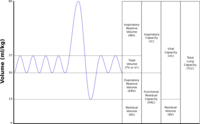
Photo from wikipedia
Background: Little has been reported on long-term pulmonary function trends among patients with interstitial lung disease associated with anti-aminoacyl-tRNA synthetase antibodies (ARS-ILD). Objectives: To clarify the factors predictive of progression… Click to show full abstract
Background: Little has been reported on long-term pulmonary function trends among patients with interstitial lung disease associated with anti-aminoacyl-tRNA synthetase antibodies (ARS-ILD). Objectives: To clarify the factors predictive of progression in ARS-ILD based on patients’ initial clinical and radiological features. Methods: The clinical courses of 88 patients with > 1 year of follow-up data on pulmonary function tests (PFTs) were retrospectively analyzed. Disease behavior was categorized into three groups: (1) improved or (2) worsened (defined as increases or decreases, respectively, of > 10% in forced vital capacity and > 15% in %diffusing capacity of lung carbon monoxide) or (3) stable based on PFT changes compared between 1-year results as the initial data and results at 3 years to assess the long-term course. Results: In the initial course of 75 patients with ARS-ILD who received anti-inflammatory therapy within 6 months after diagnosis, 48 patients (64.0%) improved and 6 patients (8.0%) worsened. The radiological patterns in the patients with ARS-ILD included nonspecific interstitial pneumonia (NSIP) in 46.7% and NSIP with organizing pneumonia overlap in 52.0% of the cases. One-third of the initially improved patients who worsened over the long-term course were assigned to the unstable group. By multivariate logistic analysis, middle lobe traction bronchiectasis was a significant predictive factor for the patients in the unstable group. Conclusions: Most patients with ARS-ILD receiving anti-inflammatory therapy had improved or remained stable in the first year. However, over the long-term course, some patients worsened despite their initial improvement. Even though the extent of the disease is limited, middle lobe traction bronchiectasis in ARS-ILD may be a useful predictor of poor long-term disease behavior.
Journal Title: Respiration
Year Published: 2018
Link to full text (if available)
Share on Social Media: Sign Up to like & get
recommendations!